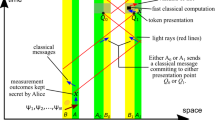Abstract
The construction of public key quantum money based on standard cryptographic assumptions is a longstanding open question. Here we introduce franchised quantum money, an alternative form of quantum money that is easier to construct. Franchised quantum money retains the features of a useful quantum money scheme, namely unforgeability and local verification: anyone can verify banknotes without communicating with the bank. In franchised quantum money, every user gets a unique secret verification key, and the scheme is secure against counterfeiting and sabotage, a new security notion that appears in the franchised model. Finally, we construct franchised quantum money and prove security assuming one-way functions.
Access this chapter
Tax calculation will be finalised at checkout
Purchases are for personal use only
Similar content being viewed by others
Notes
- 1.
[BS20] also propose a quantum money scheme that tries to approximate the functionality of PKQM. However, their scheme does not achieve local verification: their banknotes must be periodically sent back to the bank for verification. Furthermore, the way they define security is hard to justify.
- 2.
We borrow this name from [BS20].
- 3.
We thank an anonymous reviewer for suggesting these applications.
- 4.
Our proof is inspired by [AC12].
References
Aaronson, S.: Quantum copy-protection and quantum money. In: Proceedings of the 2009 24th Annual IEEE Conference on Computational Complexity, CCC ’09, Washington, DC, USA, pp. 229–242. IEEE Computer Society (2009)
Aaronson, S.: (2016). http://www.scottaaronson.com/blog/?p=2854
Aaronson, S., Christiano, P.: Quantum money from hidden subspaces. In: Proceedings of the Annual ACM Symposium on Theory of Computing (2012)
Ambainis, A.: Quantum lower bounds by quantum arguments. J. Comput. Syst. Sci. 64(4), 750–767 (2002)
Boneh, D., Naor, M.: Traitor tracing with constant size ciphertext. In: Proceedings of the 15th ACM Conference on Computer and Communications Security, CCS ’08, New York, NY, USA, pp. 501–510. Association for Computing Machinery (2008)
Behera, A., Sattath, O.: Almost public quantum coins (2020)
Chor, B., Fiat, A., Naor, M.: Tracing traitors. In: Desmedt, Y.G. (ed.) CRYPTO 1994. LNCS, vol. 839, pp. 257–270. Springer, Heidelberg (1994). https://doi.org/10.1007/3-540-48658-5_25
Farhi, E., Gosset, D., Hassidim, A., Lutomirski, A., Shor, P.: Quantum money from knots. In: Proceedings of the 3rd Innovations in Theoretical Computer Science Conference, ITCS ’12, New York, NY, USA, pp. 276–289. Association for Computing Machinery (2012)
Goyal, R., Koppula, V., Waters, B.: Collusion resistant traitor tracing from learning with errors. In: Proceedings of the 50th Annual ACM SIGACT Symposium on Theory of Computing, STOC 2018, New York, NY, USA, pp. 660–670. Association for Computing Machinery (2018)
Katz, J., Lindell, Y.: Introduction to Modern Cryptography, 2nd edn. Chapman & Htall/CRC, Boca Raton (2014)
Kitagawa, F., Nishimaki, R., Yamakawa, T.: Secure software leasing from standard assumptions (2021)
Nielsen, M.A., Chuang, I.: Quantum computation and quantum information. Am. J. Phys. 70(5), 558 (2000)
Pena, M.C., Faugère, J.-C., Perret, L.: Algebraic cryptanalysis of a quantum money scheme the noise-free case. In: Katz, J. (ed.) PKC 2015. LNCS, vol. 9020, pp. 194–213. Springer, Heidelberg (2015). https://doi.org/10.1007/978-3-662-46447-2_9
Roberts, B.: Security analysis of quantum lightning. In: Canteaut, A., Standaert, F.-X. (eds.) EUROCRYPT 2021. LNCS, vol. 12697, pp. 562–567. Springer, Cham (2021). https://doi.org/10.1007/978-3-030-77886-6_19
Radian, R., Sattath.: Semi-quantum money. In: Proceedings of the 1st ACM Conference on Advances in Financial Technologies, AFT ’19, pp. 132–146. Association for Computing Machinery (2019)
Wiesner, S.: Conjugate coding. SIGACT News 15(1), 78–88 (1983)
Zhandry, M.: Quantum lightning never strikes the same state twice. In: Ishai, Y., Rijmen, V. (eds.) EUROCRYPT 2019. LNCS, vol. 11478, pp. 408–438. Springer, Cham (2019). https://doi.org/10.1007/978-3-030-17659-4_14
Acknowledgements
This work is supported in part by NSF. Any opinions, findings and conclusions or recommendations expressed in this material are those of the author(s) and do not necessarily reflect the views of NSF.
This work is also supported by MURI Grant FA9550-18-1-0161 and ONR award N00014-17-1-3025.
We thank Zeph Landau, Umesh Vazirani, and the Princeton Writing Center for helpful feedback on various drafts of this paper.
Author information
Authors and Affiliations
Corresponding authors
Editor information
Editors and Affiliations
Rights and permissions
Copyright information
© 2021 International Association for Cryptologic Research
About this paper
Cite this paper
Roberts, B., Zhandry, M. (2021). Franchised Quantum Money. In: Tibouchi, M., Wang, H. (eds) Advances in Cryptology – ASIACRYPT 2021. ASIACRYPT 2021. Lecture Notes in Computer Science(), vol 13090. Springer, Cham. https://doi.org/10.1007/978-3-030-92062-3_19
Download citation
DOI: https://doi.org/10.1007/978-3-030-92062-3_19
Published:
Publisher Name: Springer, Cham
Print ISBN: 978-3-030-92061-6
Online ISBN: 978-3-030-92062-3
eBook Packages: Computer ScienceComputer Science (R0)





